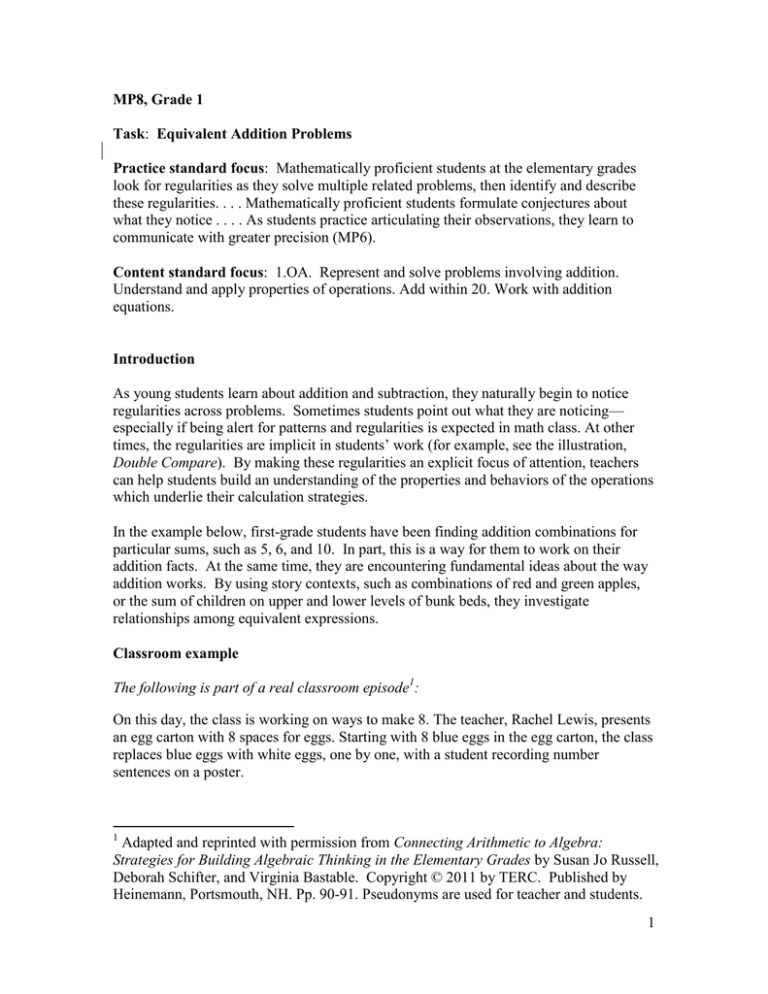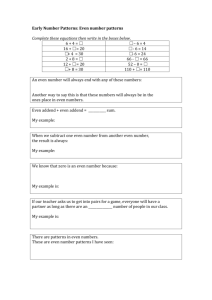1 MP8, Grade 1 Task: Equivalent Addition Problems Practice
advertisement

MP8, Grade 1 Task: Equivalent Addition Problems Practice standard focus: Mathematically proficient students at the elementary grades look for regularities as they solve multiple related problems, then identify and describe these regularities. . . . Mathematically proficient students formulate conjectures about what they notice . . . . As students practice articulating their observations, they learn to communicate with greater precision (MP6). Content standard focus: 1.OA. Represent and solve problems involving addition. Understand and apply properties of operations. Add within 20. Work with addition equations. Introduction As young students learn about addition and subtraction, they naturally begin to notice regularities across problems. Sometimes students point out what they are noticing— especially if being alert for patterns and regularities is expected in math class. At other times, the regularities are implicit in students’ work (for example, see the illustration, Double Compare). By making these regularities an explicit focus of attention, teachers can help students build an understanding of the properties and behaviors of the operations which underlie their calculation strategies. In the example below, first-grade students have been finding addition combinations for particular sums, such as 5, 6, and 10. In part, this is a way for them to work on their addition facts. At the same time, they are encountering fundamental ideas about the way addition works. By using story contexts, such as combinations of red and green apples, or the sum of children on upper and lower levels of bunk beds, they investigate relationships among equivalent expressions. Classroom example The following is part of a real classroom episode1: On this day, the class is working on ways to make 8. The teacher, Rachel Lewis, presents an egg carton with 8 spaces for eggs. Starting with 8 blue eggs in the egg carton, the class replaces blue eggs with white eggs, one by one, with a student recording number sentences on a poster. 1 Adapted and reprinted with permission from Connecting Arithmetic to Algebra: Strategies for Building Algebraic Thinking in the Elementary Grades by Susan Jo Russell, Deborah Schifter, and Virginia Bastable. Copyright © 2011 by TERC. Published by Heinemann, Portsmouth, NH. Pp. 90-91. Pseudonyms are used for teacher and students. 1 Although the students successfully represent the combinations in symbols, Ms. Lewis recognizes that there is more to learn about the symbols beyond writing number sentences correctly. As the recorder is about to write 1 + 7 = 8 on the poster, Ms. Lewis says, “Everyone just watch Talia as she writes this equation. Raise your hand if you see a pattern in our equations. Let’s give everyone thinking time.” Several students have ideas. Kamala: 7, 6, 5, 4, 3, 2, 1. It’s all going down. David: The pluses are all in a row, and the equals. All of the eights are there. They all equal 8. The carton fills with numbers until it gets to 8. The students see some patterns in the symbols: The first addend decreases by 1 in each line; the addition sign and the equal sign appear in the same positions in each line; the sum is always equal to 8. Ms. Lewis now asks questions to help the students realize how these patterns connect to the action of replacing blue eggs with white eggs. Ms. Lewis: Has anyone figured out why the other number is getting bigger? Kamala noticed that this number [pointing to the first addend] is getting smaller, but this number [the second addend] is getting bigger. Can anyone compare these equations to the eggs? I need you to look at two things at once. I want you to look at the egg carton and then up at the first equation as I keep changing the arrangement of eggs. 2 The children watch Ms. Lewis model the first two equations with the “eggs.” Squeals of understanding erupt. Kamala: They go 1, 2, 3, 4, 5 [pointing to the second addend]. Ms. Lewis: What’s happening here? Talia: If this number is going down [first addend], then this number is going up [second addend]. Ms. Lewis: Why? Talia: We switched them around. We took some different eggs and changed them with different colors. Maura: You’re taking out the blue ones and putting in the white ones. Talia: Because if you put more of one color, you have less of one color. . . . The white ones are getting bigger because we started with the blue eggs and we put in more white ones. That would make the white ones bigger and the blue ones smaller. Commentary Young students often notice patterns in numbers, as Kamala does when she says, “7, 6, 5, 4, 3, 2, 1. It’s all going down,” or as David does when he says, “The pluses are all in a row, and the equals.” This kind of description is a first step in noticing and expressing regularity, but for these observations to be valuable mathematically, students need to go beyond simply noticing patterns of symbols on the chart. By connecting the symbols to contexts—in this case, the action of swapping blue eggs for white ones, maintaining the same total number of eggs—the teacher provides a way for students to think about what the patterns in the symbols mean and why they occur. Talia and Maura begin to move beyond describing visual patterns. With her “if . . . then” statement, Talia relates how the change in one addend is related to the change in the other addend. Both Maura and Talia connect the change in the numbers to the actions on the eggs, “You’re taking out the blue ones and putting in the white ones.” These students are beginning to express the regularity. As one blue egg is replaced by one white one, the number of blue eggs decreases by 1 and the number of white eggs increases by 1. Every space in the egg carton is still filled—the total number of eggs stays the same. By asking students to “look at two things at once”—how the change in the colors of eggs in the carton is related to the change in the addition equation—the teacher is helping students make meaning for the patterns they see in the symbols. As the class continues this work, using different numbers and different contexts, they move towards articulating a conjecture about the operation of addition—that if one addend 3 increases by 1 (or some amount) and another addend decreases by 1 (or the same amount), the sum does not change. They might later go on to construct arguments based in the representations and contexts they have been using to show why this must be true (MP3). 4

